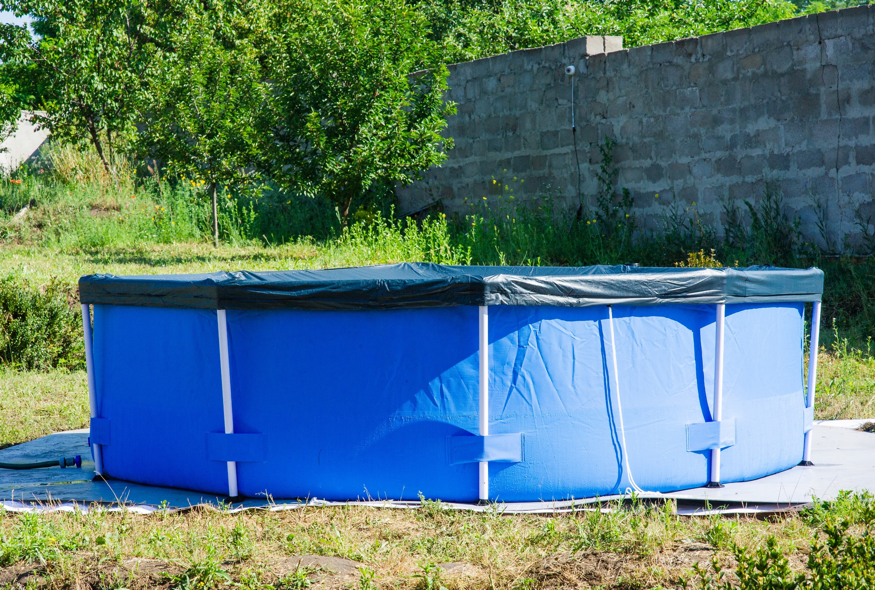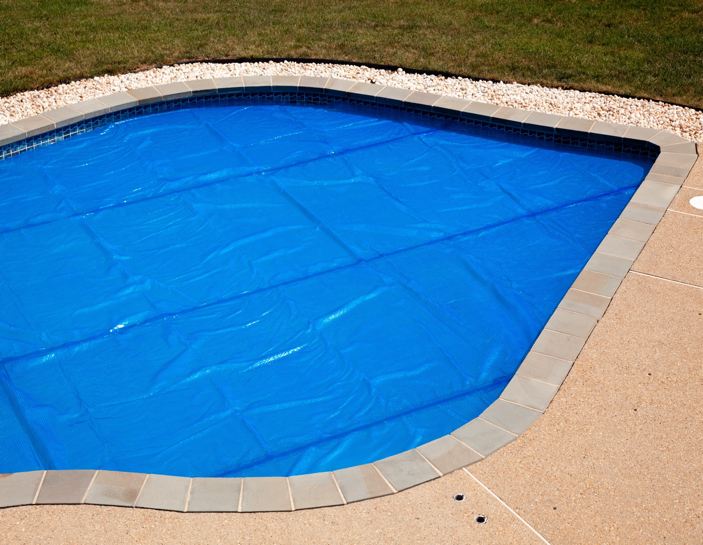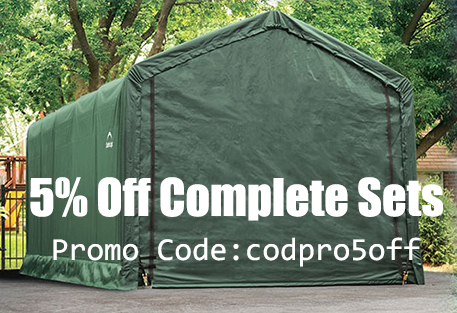How to Cover Your Swimming Pool with a Tarp: Secured 'til Summer
Posted by Canopies Tarps on Aug 14th 2025
Why Use a Tarp as a Pool Cover?
Whether you have an above-ground or in-ground pool, you likely have a pool cover or plan to get one before the seasons change. Pool covers are good for year-round protection of your pool.
While everyday pool maintenance costs can add up over the years, protecting the surface of a swimming pool between uses doesn't have to involve an expensive cover.
A simple, inexpensive tarp can be used to cover your swimming pool between seasons, while you're away or on days or weeks when you want to minimize standard pool maintenance costs. Unlike other pool maintenance work, you won't have to hire an outside professional to place a tarp over your pool.
The pros at Canopies and Tarps report that the right-size tarp makes it easy to place over your pool and secure to the perimeter with the use of bungee cords and ground stakes or other anchors.
Can you use a tarp as a pool cover? Yes. Waterproof, UV-resistant tarps work well as pool covers, and can be easily secured to protect your pool from debris, pest infestations, and other off-season issues.
What is the Best Material to Cover a Swimming Pool?
Choosing the right material is the most important decision when selecting a tarp for your pool. Most commercial and DIY covers are made from one of a few key materials.
- Vinyl is a very durable, heavy-duty material often used for professional-grade pool covers. It is a form of PVC, known for its strength and weather resistance. While it can be more expensive, vinyl is built to last for many seasons and resists punctures well.
- Polyethylene (or poly) is a common and affordable choice for tarps. It is lightweight, waterproof, and durable enough for seasonal use. It's the most common material you'll find for general-purpose tarps and is a great option for a DIY pool cover, offering a good balance of cost and performance.
- Mesh covers are made from a woven material that allows rain to pass through while still catching leaves and other large debris. The trade-off is that they are less effective at blocking sunlight, which can lead to algae growth in your pool.
Tips For Covering Your Pool With a Tarp
Getting a tarp cover for your pool is a great first step, but proper installation and care are crucial for long-term success. Follow these tips for a secure, effective, and long-lasting pool cover.
Allow for Slack on the Cover
When placing the tarp, let it rest on the water's surface instead of pulling it taut. The water in the pool will support the weight of any rain or snow, preventing the tarp from tearing or having its grommets rip out.
Secure the Edges with Care
Use water tubes or bags to weigh down the edges. They are the safest option, as they won't damage the tarp or your deck if the cover shifts. For above-ground pools, ground stakes with bungee cords are a good alternative. Fill water bags no more than two-thirds full to prevent them from expanding and bursting when they freeze.
Get a Tarp Larger Than Your Pool
A common mistake is buying a tarp that is the exact size of your pool. To properly secure the cover, you'll need a tarp that is at least a few feet larger in both length and width. This extra material provides enough fabric to be weighed down by water bags, ground stakes, or other securing methods. Our round poly tarps for above-ground pools, for example, are available in diameters such as 10 ft., 14 ft., 16 ft., and larger.
Manage Water on Top of the Cover
To prevent the wind from lifting your tarp cover, it’s a good idea to add about an inch of water to the top of it right after installation. This initial weight will help secure the cover in place. Afterward, you should still remove any standing water that accumulates from heavy rain or snow.
A Quick Installation Tip: The Fan Fold
When you take your cover off at the end of the season, try using the “fan fold” method for storage. Instead of just wadding it up, fold the cover back and forth like a fan. This makes it incredibly easy to roll out and install the following year, eliminating the need to drag the entire cover across your deck and potentially snag or rip it.
Above-Ground Pool Tarp Covers

Above-ground pools are generally left filled throughout the winter. Pool tarps help keep the pool and water under the cover controlled for the season.
A swimming pool tarp cover can help keep the water from evaporating, and it keeps leaves and other debris out of the water. If ice accumulates beneath the tarp cover in cold-weather places, the ice will melt and produce fairly clean pool water in warmer months.
Swimming pool tarps can also prevent unwanted critters, including bugs and rodents, from finding their way into the pool.
Even when the pool is open, a DIY pool cover can help keep the temperature warm by holding heat in the water by shielding it from escaping, or from being cooled by wind and outdoor temperatures.
A tarp is often easier to use than an expensive "pool cover" purchased at a pool supply store, since it is typically lighter, more flexible and has built-in grommets that can be used to secure the tarp in place.
At Canopies and Tarps, round poly tarps for above-ground swimming pools are hand-crafted in the U.S. of heavy-duty polyethylene that's UV-resistant and waterproof. They are available in 10-ft. diameter, 14-ft. diameter, 16-ft. diameter and 18-ft. diameter sizes.
Do you need a tarp under your pool? Many homeowners place a heavy-duty vinyl tarp beneath their above-ground pool to protect against punctures and possible leaks.
In-Ground Swimming Pool Tarps

In-ground pools offer year-round fun in warmer climates. In four-season regions, they can be heated to extend the traditionally warm seasons. Heated pools benefit from swimming pool tarp covers, since a cover will help hold heat in the water.
Some pool owners might feel it is a big production to cover and uncover the pool, but it will help save energy and keep the water at a comfortable temperature.
In the winter, most pool owners in colder climates drain their pools.
Even though the pool is drained, there are several reasons to keep it covered for the winter. A cover keeps water from collecting and becoming stagnant. Water that builds up in the pool can also expand as it freezes and causes stressful wear and tear on the pool, possibly cracking the pool's concrete or tile foundation.
DIY Pool Covers
There are numerous commercial pool covers both off the shelf or custom-made for your pool. These can be pricy and require replacement every few seasons. A tarp is more than suitable for the job, since many pool covers are cut from the same cloth - so to speak - and cost far less.
You can order heavy-duty tarps of 12 Mil thickness or greater to protect against harsh winters. Tarps come in every size, up to 100 ft. by 100 ft., which will cover just about any backyard swimming pool size. Custom sizes are available from respected retailers like CanopiesandTarps.com.
Grommets are used to tie the tarp into place to get a taut cover on your pool. You can use tent stakes, tie downs or other methods to secure your tarp for the night, a week or for the season.
For pool season, you can go with a thinner tarp if you want to cover your pool when not in use in order to keep leaves and other debris from falling into the pool. A heavier tarp will provide more protection in colder months or during off-seasons.
Whether you have an above-ground or in-ground pool, there are other issues to consider when covering your pool. You want to cover the pool from edge to edge, and possibly have some cover overlap with the ground or hang over the sides of the pool.
While you want the cover to keep everything out, including any critters looking for water or wet lodgings, you want a taut cover that also won't come in contact with the water. Covers that touch the water in a pool can sag. Where the water touches the cover, it can discolor due to the water or any leaves and debris lying on top of the fabric.
With a tarp as a cover, you can pack it up out of sight when not in use, so you can enjoy your season in the sun.
If you already have a backyard swimming pool, consider adding another amenity: a pop-up pool cabana from Canopies and Tarps. This fun resort-style kit includes a festive striped canopy with zippered front closure, frame and carry bag.


